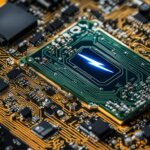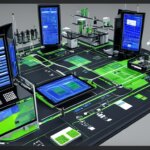Table of Contents
Electrostatic discharge (ESD) is a fundamental concept in the field of electronics. It refers to the sudden flow of electricity between two electrically charged objects, which can have a significant impact on electronic devices and components. The basics of ESD are crucial to comprehend, as they provide insights into the prevention and management of this phenomenon.
ESD has been a longstanding problem in various industries, dating back to the 1400s when efforts to control and prevent it first began. However, with the advancement of technology and the increasing sensitivity of electronic devices, the need to understand and manage ESD has become more critical than ever.
Electrostatic charges play a pivotal role in the occurrence of ESD. These charges are created through the contact and separation of materials, a process known as triboelectric charging. When materials come into contact and then separate, electrons are transferred between surfaces, resulting in a charge imbalance. The material that loses electrons becomes positively charged, while the material that gains electrons becomes negatively charged.
Understanding the impact of ESD on electronics is vital. It can cause damage or complete failure of sensitive components, leading to increased costs, decreased product reliability, and potential safety hazards. Hence, preventing and managing ESD is of utmost importance.
In the following sections, we will explore in detail how charges are created and ESD occurs, as well as strategies for the prevention and management of ESD. By building a strong foundation of knowledge in this area, you can effectively protect your electronic devices and enhance their performance and longevity.
How Charges are Created and ESD Occurs
Static charges are created through the contact and separation of materials, a process known as triboelectric charging. When two materials come into contact and then separate, electrons are transferred from one surface to the other, resulting in a charge imbalance. The material that loses electrons becomes positively charged, while the material that gains electrons becomes negatively charged. This charge imbalance can persist until a discharge occurs, either through contact with another object or through a spark.
“Triboelectric charging is a fascinating phenomenon that underlies the occurrence of static charges and the potential for electrostatic discharge. It highlights the transfer of electric charge between objects, leading to numerous applications and challenges in various industries.”
Triboelectric charging occurs due to the difference in the electron affinity and work function of materials. When two different materials come into contact, the electrons from the material with lower work function transfer to the material with higher work function, resulting in the charge separation. This charge generation mechanism is influenced by several factors, including the surface properties of the materials, such as their roughness and cleanliness, as well as environmental conditions such as humidity levels and temperature.
Charge Transfer and Field-Induced Discharge
Once the charges are generated, they can be transferred from one surface to another through various mechanisms. Direct contact between objects can allow for charge transfer, as electrons move from the material with a higher charge density to the one with a lower charge density. This transfer of charge can occur through direct surface contact or through conductive pathways, such as wires or connectors.
In addition to contact transfer, charges can also be transferred through field-induced discharge. In this process, a sufficiently high electric field can cause the charges to jump across a gap and discharge to a different material or ground. Field-induced discharge is often responsible for the sudden sparks or electrostatic shocks that we experience in our daily lives.
“Understanding the mechanisms of charge generation, transfer, and field-induced discharge is crucial for managing and preventing electrostatic discharge events. By implementing effective ESD control measures, industries can safeguard their sensitive electronics from potential damage and ensure the reliability of their products.”
Triboelectric Charging Examples:
| Material A | Material B | Charge Transfer |
|---|---|---|
| Wool | Acetate | Electrons transfer from wool to acetate, creating a positive charge on acetate and a negative charge on wool |
| Polyethylene | Styrene | Electrons transfer from styrene to polyethylene, creating a positive charge on polyethylene and a negative charge on styrene |
| Acrylic | Polyester | Electrons transfer from polyester to acrylic, creating a positive charge on acrylic and a negative charge on polyester |
Prevention and Management of ESD
Controlling electrostatic energy and preventing electrostatic discharge (ESD) is crucial in ensuring the reliability and longevity of electronic devices. Designing in immunity to static build-up is the primary method of ESD prevention.
By incorporating various protective measures, the generation and transfer of charge can be reduced, significantly lowering the likelihood of ESD. This involves using materials at the same electrostatic potential to minimize charge imbalances that can lead to discharge.
Implementing grounding pathways and using shielding and grounding enclosures within electronic systems can further mitigate the risks of ESD. Grounding pathways provide an effective route for the dissipation and neutralization of charges, preventing them from accumulating and potentially causing damage to sensitive components.
Furthermore, the careful consideration of system designs can play a crucial role in protecting against ESD. Ensuring proper insulation, shielding sensitive components, and implementing automated discharge systems are important steps in safeguarding electronics from the harmful effects of ESD.
FAQ
What is electrostatic discharge (ESD)?
Electrostatic discharge (ESD) is the sudden flow of electricity between two electrically charged objects. It can cause damage or failure to sensitive electronics.
How is ESD created?
ESD is created through the contact and separation of materials, known as triboelectric charging. When materials come into contact and then separate, electrons are transferred, resulting in a charge imbalance.
What is the impact of ESD on electronics?
ESD can have a significant impact on electronics, leading to damage or complete failure of sensitive components.
How can ESD be prevented and managed?
ESD can be prevented and managed through strategies such as designing electronics with immunity to static build-up, using materials at the same electrostatic potential, implementing grounding pathways, and using shielding and grounding enclosures.
What is field-induced discharge?
Field-induced discharge is a type of ESD that occurs when a charged object creates a high electric field that induces a discharge in another nearby object.












